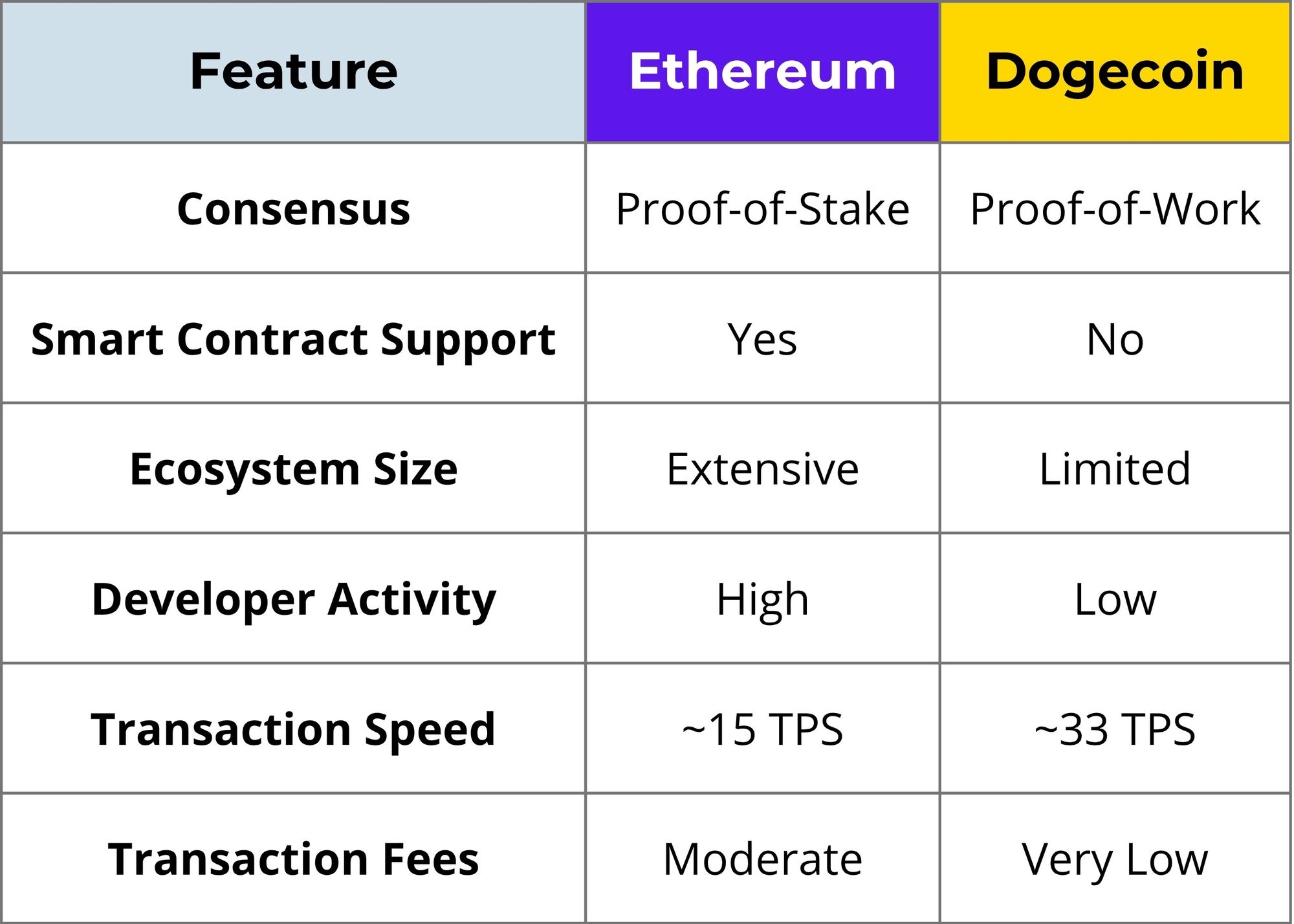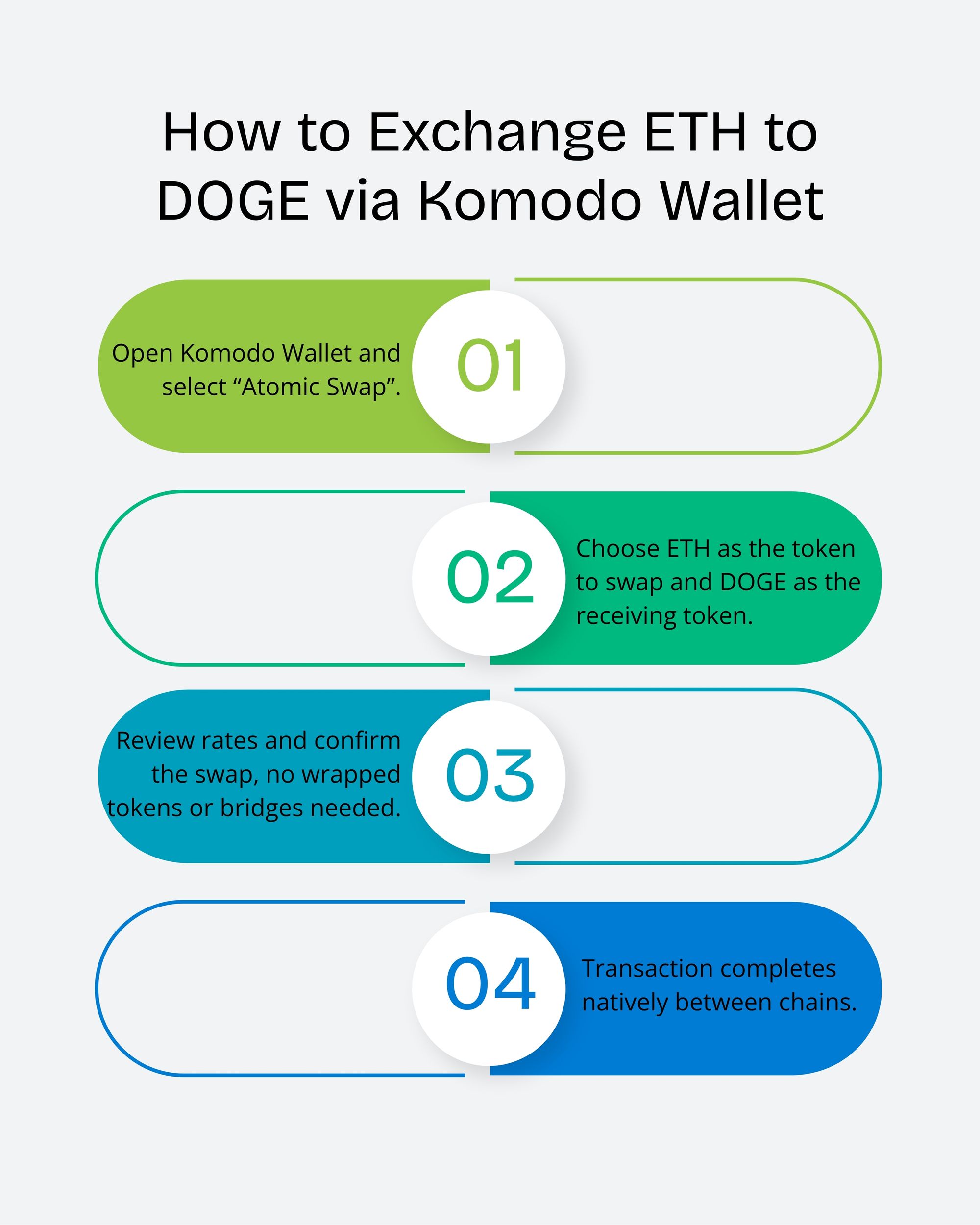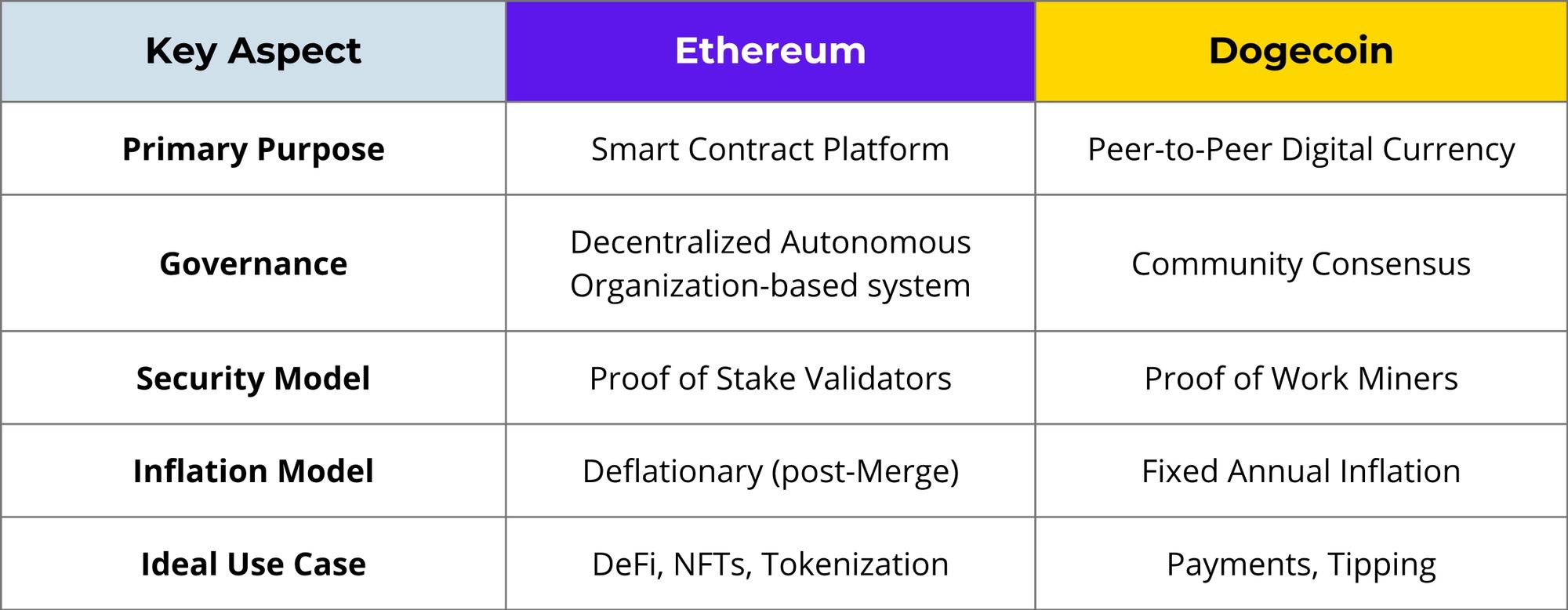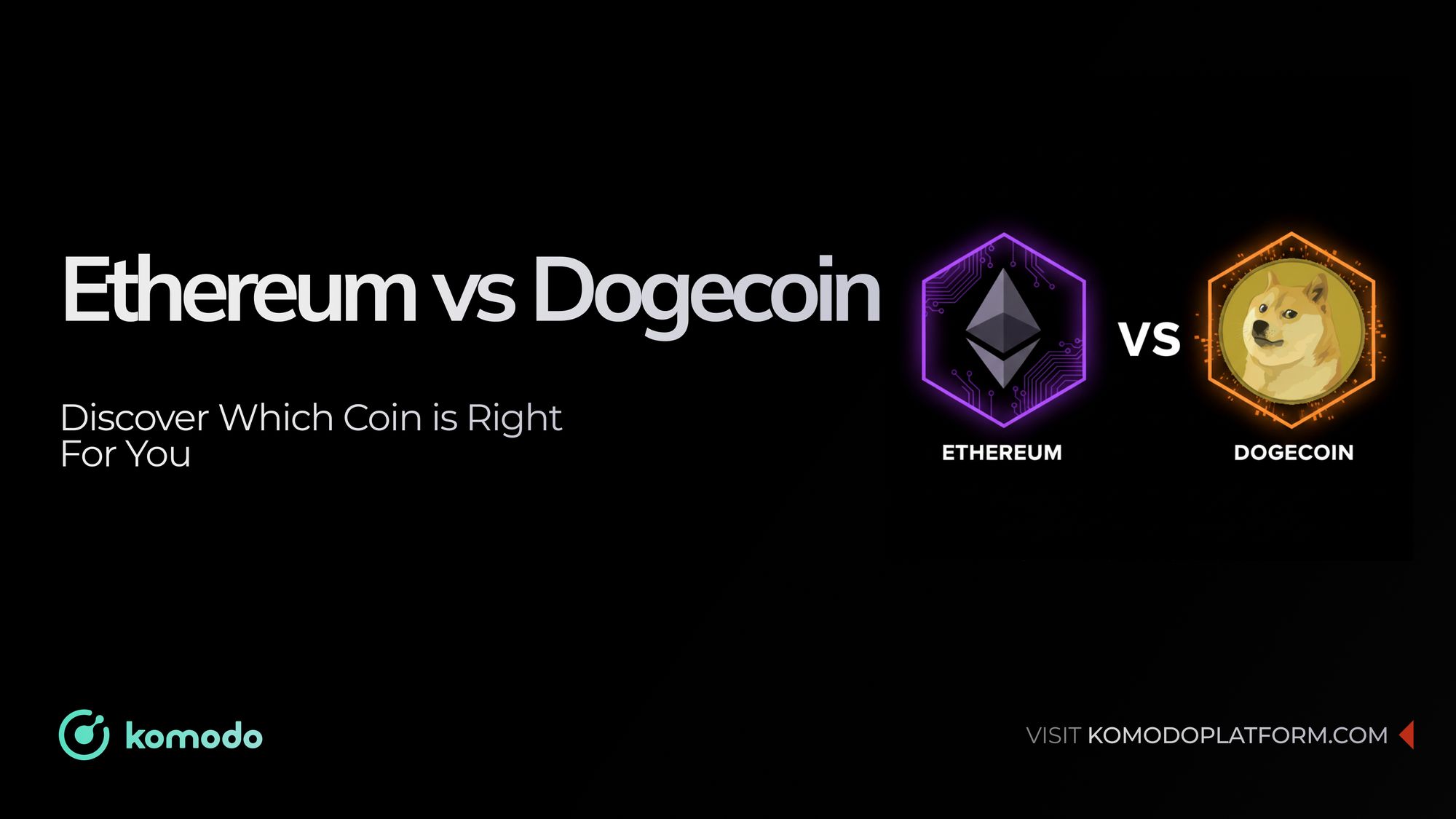These days cryptocurrency enthusiasts often compare Ethereum and Dogecoin as two of the most recognizable digital assets, yet they represent very different philosophies. Ethereum leads the decentralized finance revolution and smart contract innovation, while Dogecoin excels in simplicity, speed and community-driven adoption.
Despite their playful rivalry, both coins have built lasting influence in the crypto ecosystem. Ethereum leads the programmable blockchain space with thousands of applications and developers, whereas Dogecoin remains one of the most active peer-to-peer payment networks in use today.
Understanding how these two networks differ in purpose, technology and long-term use cases is essential for any investor or blockchain enthusiast who wants to stay informed about the market.
Quick Overview
To get a foundational visual overview of three cryptocurrencies, Bitcoin, Ethereum and Dogecoin, consider watching a comparison video below:
For a deeper dive into the technical and utility differences, check out our dedicated guide on Ethereum Vs Bitcoin: What Are the Differences?. And for an analysis of Dogecoin's unique market psychology and cultural phenomenon, read our Dogecoin insights here.
What Is Ethereum and What Is Dogecoin?
Before comparing their technology and ecosystems, let’s briefly revisit what makes each project unique in the crypto landscape.
Ethereum
Ethereum stands as a base of the decentralized world, a platform that expanded blockchain's potential far beyond simple transactions.
- Launched in 2015 as a programmable blockchain that extends Bitcoin’s vision beyond payments.
- Introduced smart contracts, enabling decentralized apps, DeFi, and NFTs.
- Transitioned to Proof-of-Stake (PoS) consensus after The Merge by reducing energy use and making scalability better.
- Serves as the foundation of Web3 by powering thousands of tokens and decentralized protocols.
Dogecoin
Starting as an internet meme, Dogecoin quickly grew into a widely recognized cryptocurrency known for its fun spirit and practical use.
- Created in 2013 as a meme-inspired cryptocurrency, originally a fork of Litecoin (if you want to know more about their connection, check out our guide: Litecoin vs. Dogecoin: What's the Difference?)
- Uses Proof-of-Work (PoW) consensus, merge-mined with Litecoin for added security.
- Known for fast, low-cost transactions and a vibrant, positive community culture.
- Popular for peer-to-peer tipping and payments, choosing simplicity over complexity.
ETH vs DOGE: Key Market Data
For a real-time look at their market performance, including current market capitalization and price movements, check out the interactive chart below:
How Each Blockchain Works
Beyond their market presence, the fundamental technology and the communities built around Ethereum and Dogecoin define their distinct roles in the crypto world. Each has a unique approach to blockchain design and what it aims to achieve.
Ethereum's Advanced Platform
Ethereum's core strength lies in its sophisticated and versatile technology, acting as a global computer for decentralized applications.
- Supports smart contracts, NFTs, DeFi and Layer 2 scalability (e.g., Arbitrum, Optimism).
- Fully EVM-compatible, letting hundreds of decentralized apps run smoothly.
Dogecoin's Straightforward Approach
Dogecoin, on the other hand, prioritizes simplicity and a strong, engaged community over complex functionalities, focusing on efficient transactions.
- Simple blockchain infrastructure, primarily for transactions and micro-payments.
- Merge-mined with Litecoin, benefiting from shared security.
- Community-driven with strong social engagement.
Key Differences Between Ethereum and Dogecoin
To summarize the core distinctions at a glance, this table highlights the key technical and ecosystem features comparing ETH and DOGE.

Benefits of DOGE and ETH
While both cryptocurrencies have multiple uses in the blockchain ecosystem, each offers unique advantages that appeal to different types of users. Dogecoin emphasizes speed and simplicity for everyday transactions, while Ethereum focuses on versatility, scalability and innovation across decentralized applications.
Dogecoin Benefits
Dogecoin’s strength lies in its ease of use and accessibility, making it a popular choice for casual users and those seeking quick, affordable digital payments. Its active online community continues to sustain adoption through social and cultural engagement. Its key benefits include:
- Fast, low-cost transfers.
- Strong community backing.
- Ideal for microtransactions and tipping culture.
Ethereum Benefits
Ethereum, on the other hand, is the backbone of decentralized innovation, powering thousands of projects in DeFi, NFTs and tokenization. Its strong developer ecosystem and ongoing upgrades make sure it remains one of the most future-ready blockchains. Its key benefits include:
- Established DeFi and NFT ecosystems.
- High developer activity and institutional interest.
- Advanced scalability with Layer 2 solutions.
How to Exchange ETH to DOGE via Komodo Wallet
Follow these steps to swap ETH for DOGE natively via Komodo Wallet:

Recent Developments
Both Ethereum and Dogecoin have continued to develop throughout this year, each strengthening its position in the crypto landscape. Ethereum’s focus has been on improving scalability and institutional adoption, while Dogecoin has moved toward becoming a more practical payment network with stronger developer engagement. Together, these updates demonstrate the growing maturity and mainstream relevance of both ecosystems.
Ethereum
Ethereum’s ongoing development roadmap makes sure long-term scalability and cost efficiency. The expansion of Layer 2 solutions and institutional use cases highlights its continued leadership as the go-to platform for decentralized innovation.
Key Updates
- Latest upgrades like Dencun improve network efficiency.
- Growing Layer 2 adoption and institutional integration.
Dogecoin
Dogecoin’s latest improvements focus on real-world usability and network stability by positioning it as a fast, community-friendly option for global payments. Its expanding integrations show that even meme-origin projects can evolve into legal payment ecosystems.
Key Updates
- Integration into payment platforms and social tipping tools.
- Ongoing developer improvements to improve security and speed.Both ETH and DOGE are fully supported for native trading on the Komodo Platform by enabling seamless cross-chain swaps.
Ethereum vs Dogecoin: Which One Works for You
To summarize, the table below highlights the core distinctions between Ethereum and Dogecoin in terms of purpose, governance, technology and ideal use cases. This quick overview can help you determine which network better aligns with your trading or development goals.

With Komodo Wallet, both ecosystems are accessible securely and natively, allowing users to manage, swap and store digital assets seamlessly.
Whether you’re managing smart contracts or sending fast, low-cost payments, Komodo Wallet provides a single, secure interface for all your digital assets.
📧Komodo Newsletter
If you'd like to learn more about blockchain technology and keep up with Komodo's progress, subscribe to our newsletter. Begin your blockchain journey with Komodo today.
FAQs about Ethereum and Dogecoin
Is Ethereum or Dogecoin Better?
Depends on use case: Ethereum for smart contracts, Dogecoin for simple transactions.
Can I Trade ETH for DOGE Without a Bridge?
Yes, using Komodo Wallet’s native atomic swaps.
Does Komodo Wallet Support Both DOGE and ETH?
Yes, it fully supports UTXO and EVM-based assets natively.
Can I Store Both Ethereum and Dogecoin in Komodo Wallet?
Yes, with full self-custody control.
